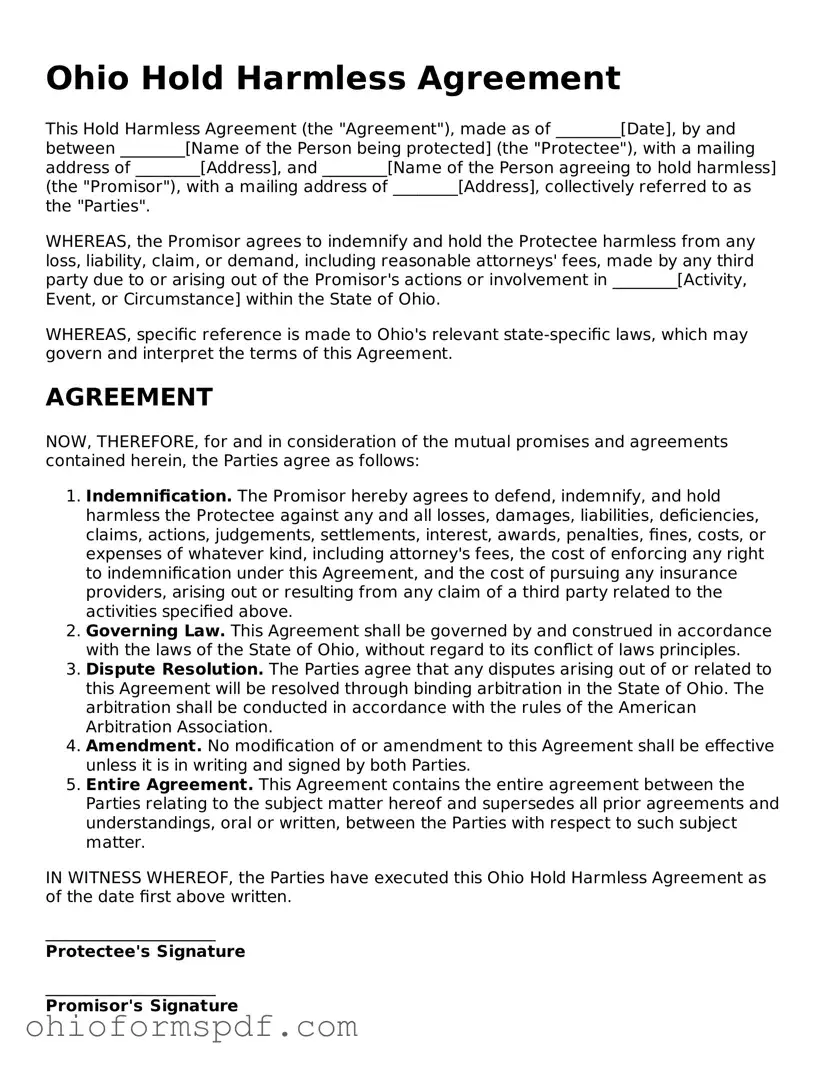What is an Ohio Hold Harmless Agreement?
An Ohio Hold Harmless Agreement is a legal document where one party agrees not to hold the other party liable for any injuries, damages, or losses that may occur during a specified activity or in a specific location. This type of agreement is commonly used in construction, property rental, and various service-related industries.
Who needs an Ohio Hold Harmless Agreement?
Individuals or businesses involved in activities that pose potential risks, such as contractors, event organizers, property owners, and service providers, might need an Ohio Hold Harmless Agreement. It is particularly relevant for those who want to protect themselves from legal claims related to accidents or injuries.
What types of liabilities can be covered by a Hold Harmless Agreement in Ohio?
A Hold Harmless Agreement in Ohio can cover various types of liabilities, including bodily injury, property damage, and legal costs associated with defending against claims. The specific coverage will depend on the terms and conditions outlined in the agreement.
Is a Hold Harmless Agreement legally enforceable in Ohio?
Yes, a Hold Harmless Agreement is generally enforceable in Ohio, provided it is clearly written, agreed upon by all relevant parties, and does not involve any fraudulent activities. However, agreements that attempt to indemnify a party for its own negligence may face enforcement challenges.
How can I create a Hold Harmless Agreement in Ohio?
To create a Hold Harmless Agreement in Ohio, it is advisable to consult with a legal professional familiar with Ohio law. The agreement should clearly outline the scope of the indemnity, the parties involved, the duration of the agreement, and any specific conditions or limitations. It should also be signed and dated by all parties.
Do all parties need to sign the Ohio Hold Harmless Agreement?
Yes, for a Hold Harmless Agreement to be effective in Ohio, all parties involved in the agreement must sign it. Signatures signify that each party understands the terms and voluntarily agrees to them.
Can a Hold Harmless Agreement in Ohio be modified?
A Hold Harmless Agreement in Ohio can be modified if all parties involved agree to the changes. Any modifications should be made in writing and signed by all parties to ensure clarity and enforceability.
What happens if a party breaches a Hold Harmless Agreement in Ohio?
If a party breaches a Hold Harmless Agreement in Ohio, the non-breaching party may have the right to take legal action. The consequences can include seeking damages, enforcing the terms of the agreement, or seeking other legal remedies as appropriate under Ohio law.
Are there any situations where a Hold Harmless Agreement might not be appropriate?
A Hold Harmless Agreement might not be appropriate in situations where the risks involved are highly uncertain or cannot be clearly defined. It may also be ineffective if it attempts to release a party from liability for intentional misconduct or gross negligence.
How long does a Hold Harmless Agreement last in Ohio?
The duration of a Hold Harmless Agreement in Ohio is determined by the terms within the agreement. Some agreements specify a fixed term, while others may remain in effect until the completion of a specific event or activity. It's crucial that the duration is clearly stated in the document.
